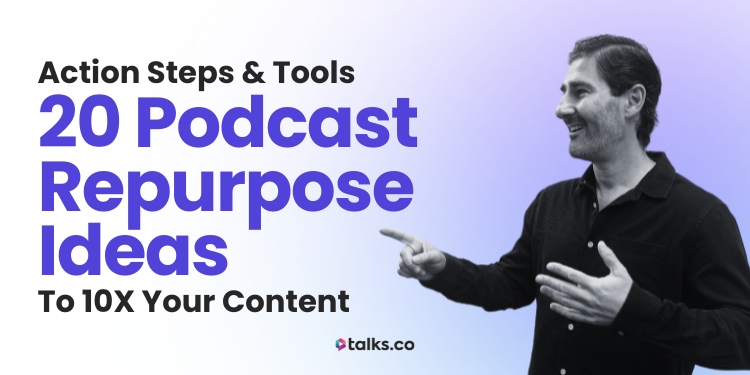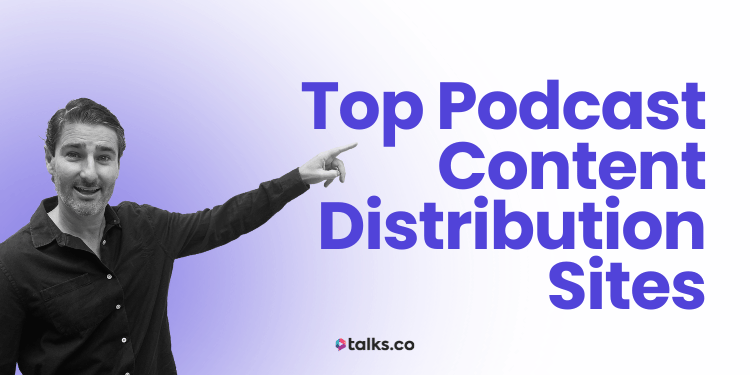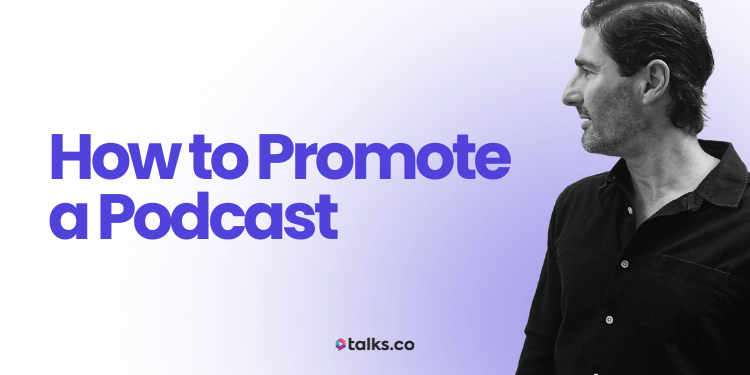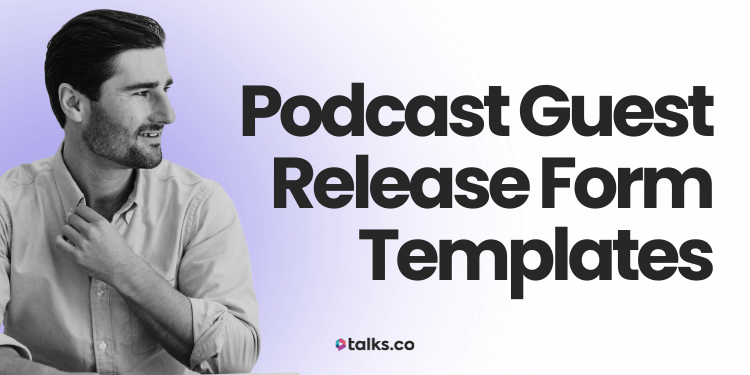Want to make your podcast episodes work harder without adding hours to your schedule? A simple podcast repurpose strategy is the key.
Every episode has more potential than just one play. That’s exactly why I repurpose interviews from my virtual summits into blog posts, daily newsletters, and social media content – keeping the conversation going long after the event ends. The same approach works for podcasts, helping you maximize reach without constantly creating new content from scratch.
You’ll learn how to repurpose podcast content, explore real examples, and tools to speed up repurposing your podcast content so you can focus on what you do best. From audiograms to social-ready clips, learn how to maximize every conversation.
What is Podcast Repurposing?
Podcast repurposing is all about reusing your already brilliant video podcast and audio content in fresh, relevant ways. Instead of letting a good conversation fade away, you transform your branded podcast content into bite-sized clips, blog posts, audiograms, and more.
This smart approach for content creators means you get to share your podcast insights on multiple platforms, which makes your content more accessible and gives your message the spotlight it deserves.
5 Best Podcast Repurpose Platforms
Different social media platforms demand different content styles. Think of tailoring the content and reformatting as podcasting 101 – knowing where to make content and how to share your social media post makes all the difference.
Here’s how to grow your podcast with new bonus content for each one:
- YouTube: YouTube loves longer, engaging video content like in-depth breakdowns and behind-the-scenes footage, making it ideal for expanding your podcast’s reach.
- Instagram: Instagram is perfect for short, eye-catching social media content, clips, and audiograms that capture attention and drive viewers back to your entire podcast episode.
- TikTok: TikTok thrives on fast, snackable content, so repurpose your podcast highlights into dynamic snippets that appeal to a younger audience.
- Threads: Threads offers a fresh, conversational space where turning your podcast insights into concise posts can tap into a new, active audience.
- LinkedIn: Transforming your podcast episodes into professional articles or posts on LinkedIn showcases your expertise and builds authority.
Each platform offers its own benefits. By repurposing your content to suit each one, you’re not just reaching more people; you’re engaging with them in a way that feels native to the platform.
12 Benefits of Podcast Repurposing
Repurposing your podcast is a no-brainer for anyone serious about getting noticed.
Here are 12 ways to repurpose your podcast content to show how podcast distribution can boost your content for maximum visibility and engagement:
- Boosts visibility: Your message reaches more eyes and ears by appearing on multiple platforms.
- Drives engagement: Diverse formats attract different segments of your podcast listeners, sparking more interaction.
- Saves time and money: Automation tools cut editing time and repurposing content so you can focus on creating new content and connecting.
- Extends content lifespan: Give your best conversations a second (or third) act, keeping them relevant for longer.
- Build authority: Consistent repurposing of content is a great way to reinforce your expertise and position you as a go-to resource.
- Expand your reach: More formats mean you’re present where your audience hangs out, from YouTube to LinkedIn.
- Improves podcast SEO: More content in various forms boosts your digital footprint and helps search engines drive traffic to your podcast.
- Refreshes evergreen content: An older episode feels new again when sliced into bite-sized clips or repackaged as a blog.
- Offers messaging versatility: Adapt your content for different platforms – a quick TikTok tip or an in-depth LinkedIn post.
- Encourages consistency: A stockpile of repurposed, captivating content keeps your posting schedule regular without burning you out.
- Sparks creativity: Experiment with different formats like audiograms and infographics to see what additional content clicks with your audience.
- Maximizes ROI: Every minute you record pays off multiple times when repurposed. Multiplying your content’s value by repurposing existing content is how you grow a podcast.
How to Repurpose Podcast Content
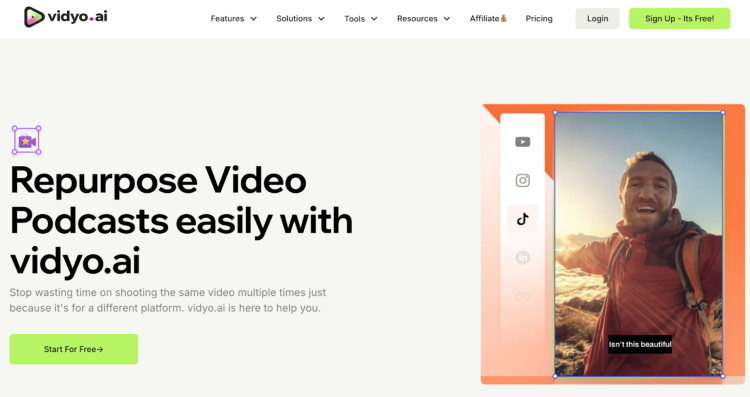
Repurposing your podcast is all about making your podcast content work harder – turning one episode into multiple, platform-ready gems. Follow these five simple steps to get the most out of every recording:
- Set clear objectives: Decide your goal for each episode (traffic, authority, or engagement) and pick your target platforms (YouTube, Instagram, TikTok, Threads, LinkedIn).
- Map out your content calendar: Schedule your repurposed pieces in advance using a simple tool like a spreadsheet or ClickUp to keep things organized.
- Choose your tools: Use editing and podcast transcription software like Vidyo.ai or Headliner to quickly convert content from your podcast with AI into clips, audiograms, and more.
- Set measurable goals: Define what success looks like – whether it’s views, engagement, or clicks – and track your progress.
- Document your process: Create a simple checklist of steps to ensure you stay consistent and save time on future episodes.
20 Ways to Repurpose Podcast Content
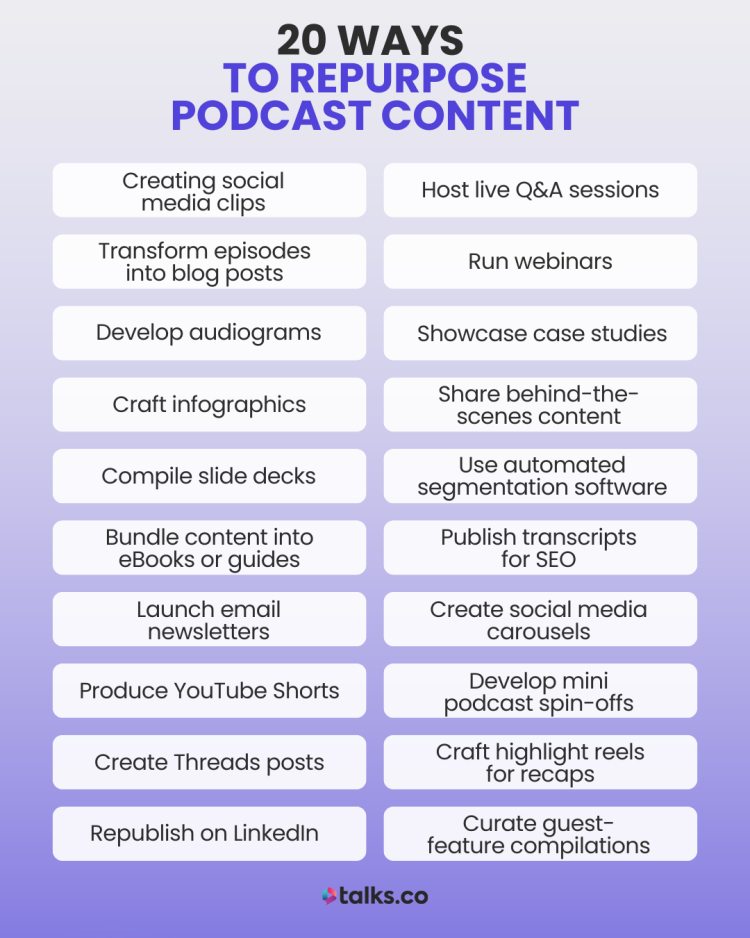
Looking to get more mileage from every podcast episode? These 20 practical methods show you how to turn a single recording into multiple high-impact pieces that drive traffic and build your audience.
1. Creating social media clips

Chop out the best bits of your podcast into short clips perfect for Instagram, TikTok, and Facebook. For example, Jay Shetty turns key insights from his On Purpose Podcast into quick clips that have helped him boost engagement and drive more traffic to his full episodes.
2. Transform episodes into blog posts

Convert your podcast transcripts or main takeaways into in-depth blog posts that improve your SEO and attract organic traffic. Pat Flynn from Smart Passive Income often transforms episodes into comprehensive articles, drawing in readers who then become loyal listeners.
3. Develop audiograms

Create engaging audiograms by overlaying audio snippets with captions and visuals. Sounds True uses audiograms for The Michael Singer Podcast to capture attention on YouTube, turning soundbites into shareable content.
4. Craft infographics
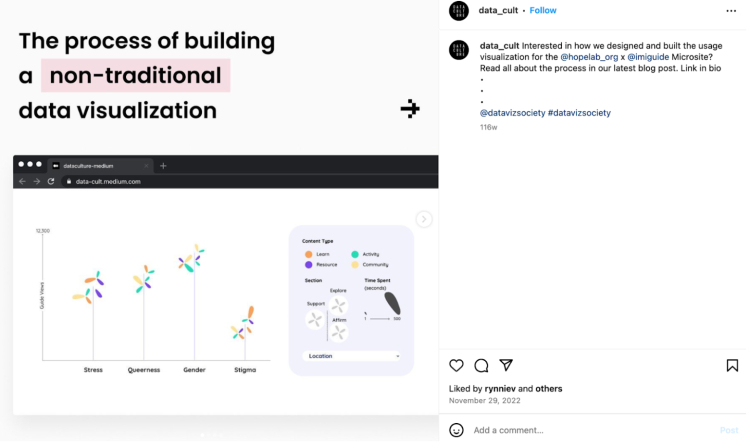
Visualize key statistics, quotes from your podcast, or insights from your episodes into attractive infographics. Infographics are highly shareable and can drive up engagement rates, especially when posted on platforms like Pinterest and Instagram.
5. Compile slide decks
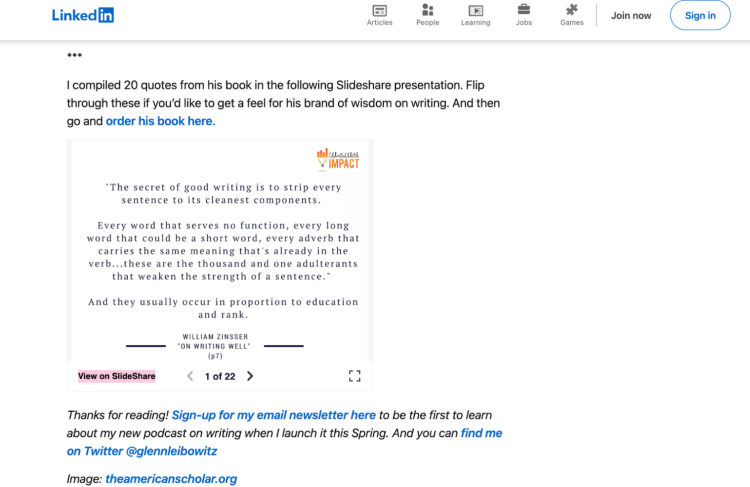
Repurpose your content into slide decks for presentations, webinars, or sharing on platforms like LinkedIn SlideShare. This format breaks down complex topics into digestible visuals that your audience can easily follow.
6. Bundle content into eBooks or guides
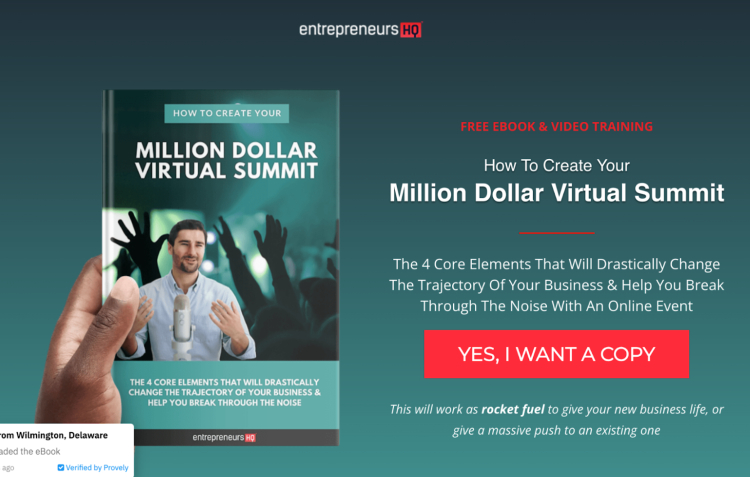
Combine insights from several episodes into an e-book or guide that you offer as a free download. Many podcasters use e-books to build their email lists and cement their authority, like my free eBook, How to Create Your Million Dollar Virtual Summit.
7. Launch email newsletters

Use snippets, summaries, or exclusive insights from your recent podcast episodes as content to create your email newsletters. Well-curated newsletter content like Mel Robbins’ Newsletter keeps your subscribers engaged and drives repeat traffic to your podcast and website.
8. Produce YouTube Shorts
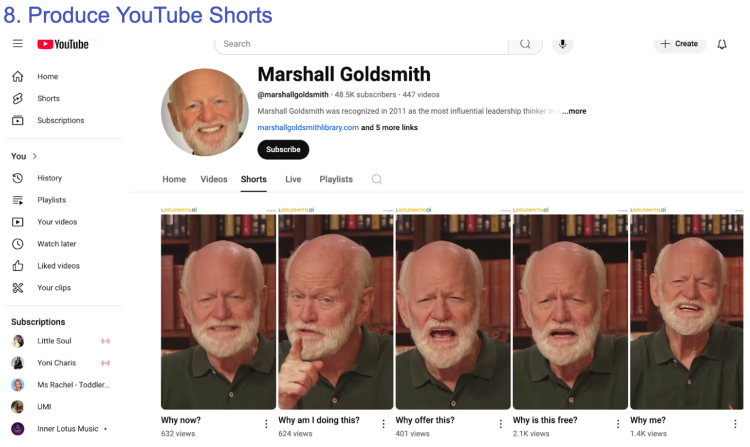
Repurposing podcast episodes into quick, snappy videos for YouTube Shorts is an effective content marketing strategy that captures key moments in a mobile-friendly format. This podcast marketing format is perfect for reaching a broader audience and driving viewers back to your full podcast episodes.
9. Create Threads posts

Repurpose your content into a series of engaging posts on Threads to tap into a fresh, growing social audience. As more users migrate to Threads, sharing bite-sized insights here can set you apart and boost your engagement.
10. Republish on LinkedIn
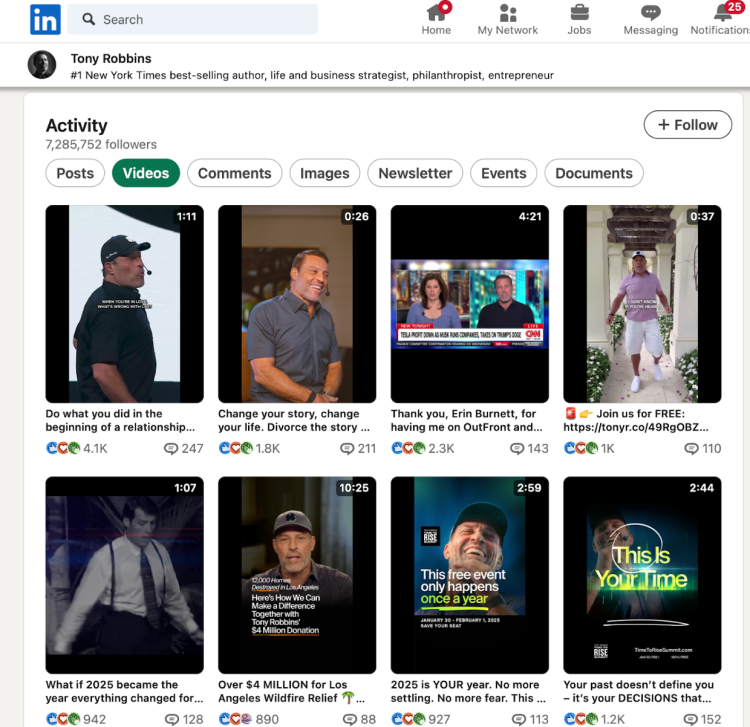
Repurpose your podcast episodes into professional articles or posts on LinkedIn to reach a business-minded audience. This podcast content strategy helps establish your expertise and attracts potential clients who value in-depth insights.
11. Host live Q&A sessions
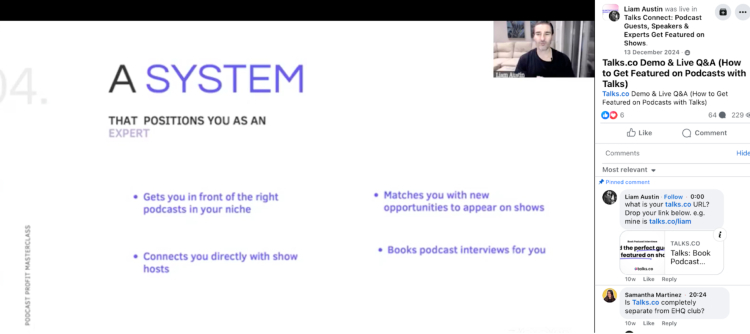
Use your podcast content as a springboard for live Q&A sessions where you dive deeper and answer audience questions. I frequently host live Q&A sessions on the Talks Connect Facebook Group to build direct engagement and create a closer connection with everyone in the group.
12. Run webinars

Organize webinars that expand on the topics discussed in your episodes, offering a more interactive format. Podcasters like Sara Artemesia of The Plant Spirit Podcast host free webinars, which not only educate but also convert viewers into loyal followers.
13. Showcase case studies
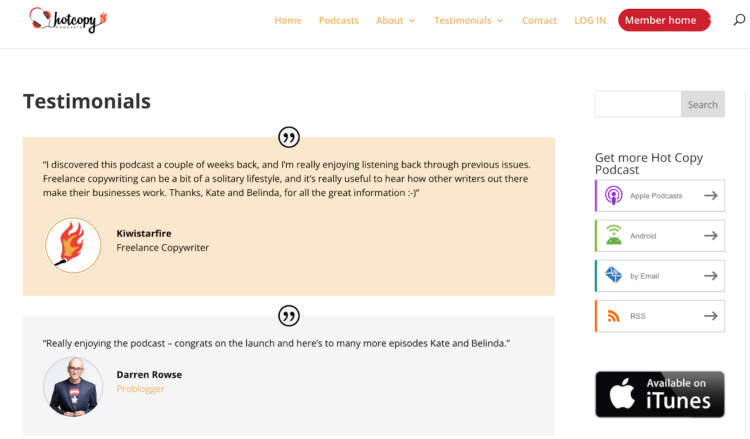
Turn your episode transcripts into SEO-friendly content by publishing them as articles. Tools like Otter.ai and Riverside make transcribing your podcast episodes a breeze, and podcasts like Freakonomics Radio Network use transcripts and podcast show notes to improve search visibility on podcast platforms.
14. Share behind-the-scenes content
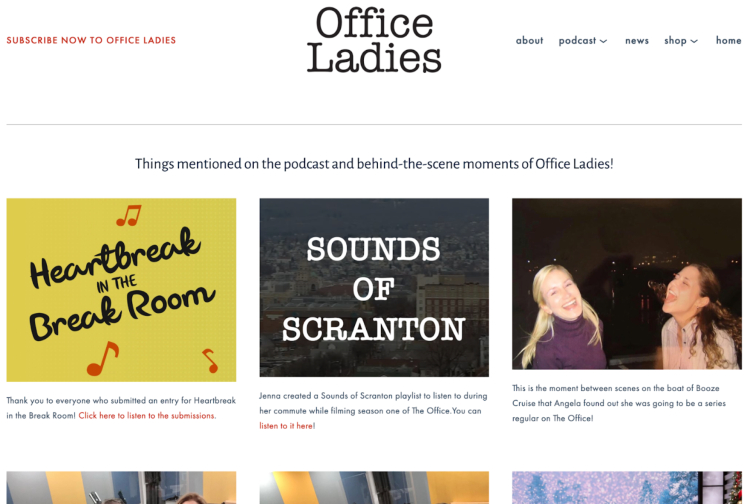
Give your audience a peek behind the curtain – show your recording setup, the team, or even a blooper reel. Office Ladies often share behind-the-scenes content to build a more personal connection with their fans and listeners.
15. Use automated segmentation software

Tools like Opus Clip or Minvo automatically clip and format your episodes for different platforms. These tools save time and ensure your content is perfectly tailored for each channel.
16. Publish transcripts for SEO
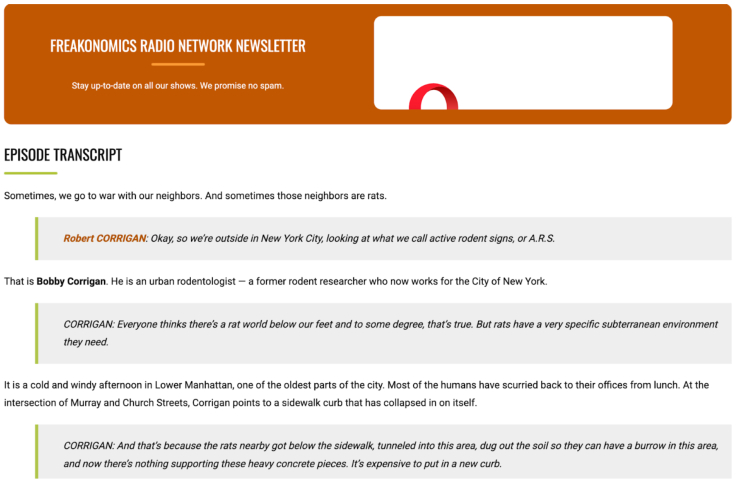
Turn your episode transcripts into SEO-friendly content by publishing them as articles. Tools like Otter.ai and Riverside make transcription a breeze, and podcasts like Freakonomics Radio Network use transcripts to improve search visibility.
17. Create social media carousels

Break down key insights into a carousel post on Instagram or LinkedIn that tells a story over multiple slides. Podcast creators like The Photowalk Podcast repurpose their best podcast content this way to keep their audience engaged slide after slide.
18. Develop mini podcast spin-offs

Extract a recurring theme or topic from your main episodes and turn it into a shorter, focused mini-series. This approach is used in Serial with their We Were Three episode to dive deeper into true stories without launching a whole new show.
19. Craft highlight reels for recaps

Edit together a highlight reel from several episodes to showcase your best moments in one go. Lewis Howes’ The School of Greatness offers highlights that give new listeners a quick overview of the show’s value.
20. Curate guest-feature compilations
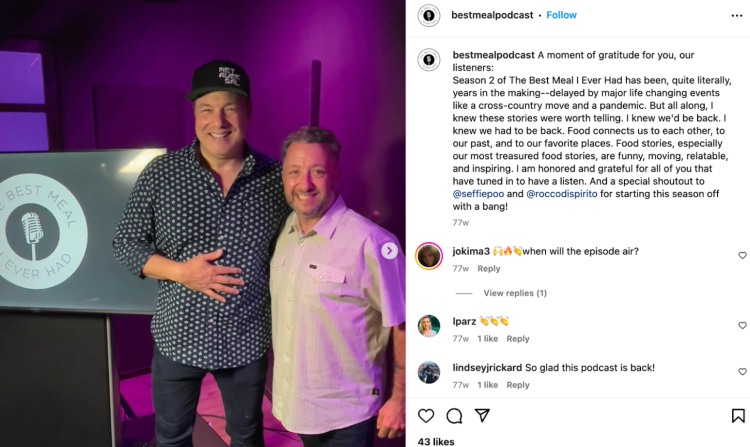
Combine clips from various guest interviews into a themed compilation episode that highlights expert insights. The Best Meal Podcast often features guest compilations to showcase diverse perspectives from its wide range of interviews.
Repurpose Podcast Content for Social Media
Your podcast has way more potential than just one episode drop. Social media is where you turn those conversations into bite-sized, engaging content that keeps your audience coming back.
If you’re wondering how to promote your podcast on social media, here are fresh ways to repurpose your content:
- Create teaser trailers for upcoming episodes: Turn highlights from your next episode into a short, exciting trailer to build anticipation. Add a countdown or “coming soon” sticker to keep engagement high.
- Post “Did You Know?” facts from your episodes: Extract surprising stats, insights, or quotes and share them as standalone posts with eye-catching visuals. Great for platforms like Instagram, LinkedIn, and Facebook.
- Make meme-worthy moments: Turn funny or relatable moments into memes, reaction GIFs, or captioned stills. Humor increases shareability, making your content more viral.
- Share audience shoutouts and testimonials: Feature comments, reviews, or messages from listeners. Screenshot and post them with a thank-you note to build community around your podcast and encourage more engagement.
- Host interactive “Would You Rather” or poll-style posts: Take a key debate or topic from your episode and turn it into an interactive post. Ask followers to vote, comment, or tag a friend for more engagement.
- Share time-stamped episode guides: Post a simple graphic breaking down key timestamps from your episode, helping listeners jump to the parts that interest them most.
- Run “Throwback” posts featuring past episodes: Bring older content back to life by resharing timeless insights from past episodes, linking to the full discussion. Add a fresh take or a new perspective to keep it relevant.
- Create “Podcast Guest vs. AI” posts: Take a key insight from your guest and compare it to an AI-generated response. Let your audience decide which is better – this starts a friendly competition and engagement.
How Often to Release Podcast Episodes
Finding the right release schedule is about balancing consistency with quality – your audience should know when to expect fresh content without feeling overwhelmed. Here’s a quick guide to help you:
- Find your rhythm: Choose a frequency (weekly, bi-weekly, or monthly) that fits your lifestyle and keeps listeners coming back.
- Prioritize quality: Make each episode count. Don’t sacrifice quality just to stick to a schedule; your audience deserves the best content worth their time.
- Let data guide you: Check your analytics to see when your audience is most engaged and adjust accordingly.
- Test and tweak: Experiment with different release days and times until you find your sweet spot.
- Plan ahead: Slot your episodes into a content calendar to stay organized and avoid last-minute scrambles.
3 Best Software to Repurpose Podcast Content
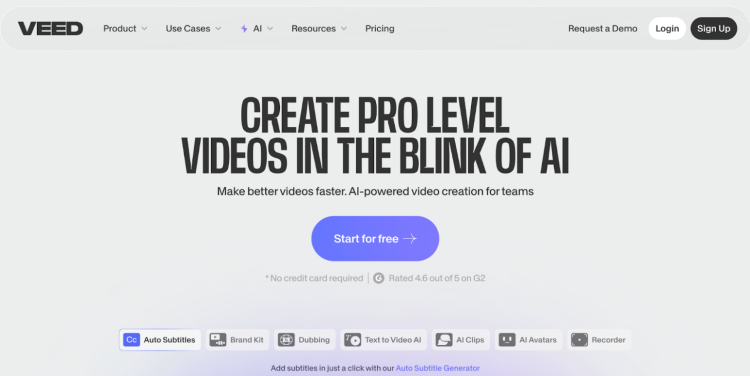
No one wants to spend endless hours chopping and editing every episode. Luckily, the best software for podcast interviews makes repurposing your podcast a breeze – letting you focus on sharing your message with the world.
- Zubtitle: Zubtitle automatically adds captions and creates snappy video clips making sure your message is seen even without sound.
- Kapwing: Kapwing is a versatile, user-friendly video editor that lets you quickly repurpose your podcast into eye-catching visuals, add subtitles, trim segments, or create stylish montage videos.
- VEED.io: VEED.io is an AI tool with an intuitive interface that adds AI-generated content like captions, effects, and transitions to make sure your repurposed content looks polished and professional.
Podcast Content Repurposing Service

When managing every clip, transcript, and edit starts to feel like a real full-time job, it’s time to let the professionals handle it.
A repurposing service takes your raw recordings and turns them into polished content for YouTube, Instagram, LinkedIn, and more – boosting engagement and driving real results, so you can focus on doing what you love.
For trusted repurposing podcast content services, check out Content10X and Content by Em.
Podcast Content Repurposing Workflow
Ready to turn one solid podcast episode into a suite of high-impact content? Here’s a simple, step-by-step workflow to easily repurpose your podcast content – think of it as your content creation playbook.
Step 1: Plan your content
- Set your objectives: Before you upload your podcast, decide what you want to achieve with each episode (e.g., boost traffic, build authority, drive engagement).
- Pick your platforms: Identify which social media platforms you’ll target – YouTube, Instagram, TikTok, LinkedIn, or Threads.
- Brainstorm podcast repurpose ideas: Jot down how each branded podcast segment can become a video clip, blog post, audiogram, infographic, or social media carousel.
- Map it out: Use a simple content calendar (Google Calendar, Trello, whatever works for you) to schedule your repurposed media content and send out your podcast guest release form.
Step 2: Record & identify key moments
- Record with repurposing in mind: Keep an ear out for standout moments within your podcast episode.
- Take timestamps: Note the podcast audio timecodes of those golden nuggets as you record or during your review.
- Transcribe your episode: Use tools like Restream or Buzzsprout to turn your audio into text-based content – this makes it easier to spot content to repurpose.
Step 3: Edit and format for each platform
- Clip video segments: Use tools like Kapwing or VEED.io to slice your key moments into short video clips tailored for each platform.
- Create audiograms: Transform your audio snippets into shareable audiograms using Zubtitle or similar software.
- Write blog posts or articles: Convert transcripts or episode summaries into written content that can be posted on your website or LinkedIn.
- Design visuals: Use Canva to craft infographics, quote cards, or social media carousels that highlight your main takeaways.
Step 4: Schedule and publish
- Set a posting schedule: Plan your release dates for each repurposed piece using your content calendar.
- Tailor your messaging: Adjust the tone and format of each piece to fit the platform – what works on Instagram might need a longer form on LinkedIn.
- Cross-promote: Share your content across multiple channels to create a network of touchpoints, driving traffic back and forth.
Step 5: Monitor, analyze and improve
- Track your performance: Use native analytics on each platform (YouTube Analytics, Instagram Insights, etc.) to see what’s resonating.
- Gather feedback: Ask your audience what they like – simple polls or comment feedback can work wonders.
- Refine your process: Adjust your workflow based on data and feedback. Over time, you’ll fine-tune a system that consistently drives engagement.
- Document your strategy: Keep a simple log or checklist of what works and what doesn’t, so you’re ready for your next episode.
More Reach, Less Work
Your podcast shouldn’t just be a one-and-done deal. With the right podcast repurpose strategies, each episode can live on across multiple platforms, bringing in more listeners, engagement, and opportunities – without extra effort.
If you’re serious about expanding your reach and maximizing your content, it’s time to get strategic. Join Talks and connect with podcasters who are making the most of their content.
Create your free Talks profile now and start getting more from every episode.
